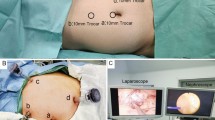Abstract
Pelvic kidney stones remain a unique challenge to the endourologists. Treatment options include open surgery, extracorporeal shockwave lithotripsy, percutaneous nephrolithotomy (PNL), retrograde intrarenal surgery, and laparoscopy assisted PNL (LA-PNL). As a minimal invasive option, LA-PNL can decrease the risk for bowel and major vessel injury. Here, we describe our experience using the LA-PNL procedures with different combinations, to treat kidney stones in multiple patients with a pelvic ectopic kidney (PEK). Eight patients, with PEK, kidney stones, and no other treatment choice, but open surgery, were included in the study. Two different laparoscopic techniques such as mesocolon dissection and transmesocolic, and four different percutaneous procedures such as standard-PNL, mini-PNL, micro-PNL, and a PNL through the renal pelvis were used for stone extraction in these patients. The mean age of patients was 25.6 ± 12.9 years and mean stone size was 524.1 ± 430.3 mm2. Mean operation time was 150.5 ± 40.0 (77–210) min which was composed of retrograde catheterization (14.8 ± 2.9 min), laparoscopic procedure (48.7 ± 20.6 min) and PNL procedure (86.8 ± 31.1 min). Residual stones were seen in two patients (no additional treatment was need), while a ‘stone-free’ procedure was achieved in six patients (75.0 %). On the post-operative first month visit, a stone was observed on radiological examinations in only one patient (87.5 % stone-free). Mean hospitalization time was 2.8 ± 0.9 days. No perioperative or post-operative complication was observed in all patients. LA-PNL surgery is a safe and effective option for treatment of PEK stones, and has several alternative approaches.




Similar content being viewed by others
References
Lang EK (1987) Percutaneous nephrostolithotomy and lithotripsy: a multi-institutional survey of complications. Radiology 162(1 Pt 1):25–30
Michel MS, Trojan L, Rassweiler JJ (2007) Complications in percutaneous nephrolithotomy. Eur Urol 51(4):899–906. doi:10.1016/j.eururo.2006.10.020 (discussion 906)
Rudnick DM, Stoller ML (1999) Complications of percutaneous nephrostolithotomy. Can J Urol 6(5):872–875
Desai MR, Jasani A (2000) Percutaneous nephrolithotripsy in ectopic kidneys. J Endourol 14(3):289–292
Goel R, Yadav R, Gupta NP, Aron M (2006) Laparoscopic assisted percutaneous nephrolithotomy (PCNL) in ectopic kidneys: two different techniques. Int Urol Nephrol 38(1):75–78. doi:10.1007/s11255-005-3611-9
Desai MR, Sharma R, Mishra S, Sabnis RB, Stief C, Bader M (2011) Single-step percutaneous nephrolithotomy (microperc): the initial clinical report. J Urol 186(1):140–145. doi:10.1016/j.juro.2011.03.029
Matlaga BR, Kim SC, Watkins SL, Kuo RL, Munch LC, Lingeman JE (2006) Percutaneous nephrolithotomy for ectopic kidneys: over, around, or through. Urology 67(3):513–517. doi:10.1016/j.urology.2005.09.056
Weizer AZ, Springhart WP, Ekeruo WO, Matlaga BR, Tan YH, Assimos DG, Preminger GM (2005) Ureteroscopic management of renal calculi in anomalous kidneys. Urology 65(2):265–269. doi:10.1016/j.urology.2004.09.055
Ugurlu IM, Akman T, Binbay M, Tekinarslan E, Yazici O, Akbulut MF, Ozgor F, Muslumanoglu AY (2015) Outcomes of retrograde flexible ureteroscopy and laser lithotripsy for stone disease in patients with anomalous kidneys. Urolithiasis 43(1):77–82. doi:10.1007/s00240-014-0713-9
Cinman NM, Okeke Z, Smith AD (2007) Pelvic kidney: associated diseases and treatment. J Endourol Endourol Soc 21(8):836–842. doi:10.1089/end.2007.9945
Eshghi AM, Roth JS, Smith AD (1985) Percutaneous transperitoneal approach to a pelvic kidney for endourological removal of staghorn calculus. J Urol 134(3):525–527
Holman E, Toth C (1998) Laparoscopically assisted percutaneous transperitoneal nephrolithotomy in pelvic dystopic kidneys: experience in 15 successful cases. J Laparoendosc Adv Surg Tech Part A 8(6):431–435
Basal S, Ozgok Y, Tahmaz L, Atim A, Zor M, Bilgic S, Istanbulluoglu O (2011) Extraperitoneal laparoscopy-assisted percutaneous nephrolithotomy in a patient with osteogenesis imperfecta. Urol Res 39(1):73–76. doi:10.1007/s00240-010-0263-8
Tepeler A, Silay MS, Armagan A, Basibuyuk I, Akman T, Akcay M, Onol SY (2013) Laparoscopic-assisted “microperc” of a stone in a pelvic kidney of a 3-year-old girl. J Laparoendosc Adv Surg Tech Part A 23(2):174–176. doi:10.1089/lap.2012.0270
Zafar FS, Lingeman JE (1996) Value of laparoscopy in the management of calculi complicating renal malformations. J Endourol Endourol Soc 10(4):379–383
Troxel SA, Low RK, Das S (2002) Extraperitoneal laparoscopy-assisted percutaneous nephrolithotomy in a left pelvic kidney. J Endourol Endourol Soc 16(9):655–657. doi:10.1089/089277902761402998
Otano N, Jairath A, Mishra S, Ganpule A, Sabnis R, Desai M (2015) Percutaneous nephrolithotomy in pelvic kidneys: is the ultrasound-guided puncture safe? Urology 85(1):55–58. doi:10.1016/j.urology.2014.08.015
El-Kappany HA, El-Nahas AR, Shoma AM, El-Tabey NA, Eraky I, El-Kenawy MR (2007) Combination of laparoscopy and nephroscopy for treatment of stones in pelvic ectopic kidneys. J Endourol Endourol Soc 21(10):1131–1136. doi:10.1089/end.2007.9930
Tahmaz L, Ozgok Y, Zor M, Basal S, Kilciler M, Istanbulluoglu O, Dayanc M (2009) Laparoscopy-assisted tubeless percutaneous nephrolithotomy in previously operated ectopic pelvic kidney with fragmented J–J stent. Urol Res 37(5):257–260. doi:10.1007/s00240-009-0205-5
Mehmet RM, Rustu YF, Hanefi B, Mursel D, Fusun A, Mehmet I (2013) Direct pelvic access percutaneous nephrolithotomy in management of ectopic kidney stone: a case report and literature review. Ren Fail 35(10):1440–1444. doi:10.3109/0886022x.2013.828357
Author information
Authors and Affiliations
Corresponding author
Ethics declarations
Conflict of interest
None.
Rights and permissions
About this article
Cite this article
Soylemez, H., Penbegül, N., Utangac, M.M. et al. Laparoscopy assisted percutaneous stone surgery can be performed in multiple ways for pelvic ectopic kidneys. Urolithiasis 44, 345–352 (2016). https://doi.org/10.1007/s00240-015-0829-6
Received:
Accepted:
Published:
Issue Date:
DOI: https://doi.org/10.1007/s00240-015-0829-6




